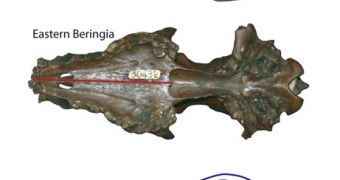In a world of giants, wolves had to be larger. And they were. Alaskan gray wolves from the last Ice Age were built to eat on mammoths, not deer. They had shorter snouts, stronger jaws and more massive canine teeth than any modern wolf. But this type of wolf vanished along with the megafauna formed by mastodons, saber-toothed cats and other big beasts at the end of the Ice Age, about 10,000 years ago.
A new research found this based on the analysis of skull and tooth bones coming from the permafrost (frozen soil), assessing bone shape and DNA and chemical signatures in the bones.
"Certainly, competition would favor those adaptations," said co-author Blaire Van Valkenburgh, a professor of ecology and evolutionary biology at the University of California, Los Angeles.
"The ancient wolves in Alaska didn't have to compete with larger relatives called dire wolves. This allowed the Alaskan gray wolves to fill a niche unavailable to gray wolf populations farther south. If there are advantages, as there generally are, to being stronger, then evolution will proceed in that direction. The ancient Alaskan wolves' short snouts, broad skulls, and large teeth indicate a specialization for big bite forces," she added.
Many of the teeth were worn down and fractured, signaling the wolves had eaten the bones, similar to Ice Age dire wolves found in tar pits in California.
"If you killed something, you were likely to have someone come and try to steal it, and so it would behoove you to eat very rapidly and to consume as much of what you killed as possible," Van Valkenburgh said.
Chemical analysis showed the giant wolves ate mammoth, musk ox, bison and horse, and they were genetically distinct from any modern wolves.
"If this animal were alive today, it would be classified as a distinct subspecies," said Van Valkenburgh.
The giant Alaskan wolves vanished at the end of the Ice Age and several hypotheses have been emitted: overhunting by humans, warming climate doomed the animals or a recent controversial theory about a comet or meteor that exploded over northern North America, triggering massive extinctions.
Still, "it's most likely that the carnivores went extinct as a result of their prey going extinct." said Van Valkenburgh.

 14 DAY TRIAL //
14 DAY TRIAL //